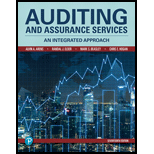
Auditing And Assurance Services
17th Edition
ISBN: 9780134897431
Author: ARENS, Alvin A.
Publisher: PEARSON
expand_more
expand_more
format_list_bulleted
Question
Chapter 22, Problem 18.3MCQ
To determine
Indicate the internal control which will least likely reduce risk related to the occurrence transaction related audit objective for issuance of stock.
Expert Solution & Answer
Want to see the full answer?
Check out a sample textbook solution
Students have asked these similar questions
What is the sales volume variance for total revenue?
Provide Answer
Can you solve this general accounting problem with appropriate steps and explanations?
Chapter 22 Solutions
Auditing And Assurance Services
Ch. 22 - List four examples of interest-bearing liability...Ch. 22 - Prob. 2RQCh. 22 - Prob. 3RQCh. 22 - Prob. 4RQCh. 22 - Prob. 5RQCh. 22 - Distinguish between (a) tests of controls and...Ch. 22 - Prob. 7RQCh. 22 - Prob. 8RQCh. 22 - Prob. 9RQCh. 22 - Prob. 10RQ
Ch. 22 - Prob. 11RQCh. 22 - Prob. 12RQCh. 22 - Prob. 13RQCh. 22 - Prob. 14RQCh. 22 - Prob. 15RQCh. 22 - Explain the relationship between the audit of...Ch. 22 - Prob. 17.1MCQCh. 22 - Prob. 17.2MCQCh. 22 - Prob. 17.3MCQCh. 22 - Prob. 18.1MCQCh. 22 - Prob. 18.2MCQCh. 22 - Prob. 18.3MCQCh. 22 - Prob. 19.1MCQCh. 22 - Prob. 19.2MCQCh. 22 - Prob. 19.3MCQCh. 22 - Prob. 20DQPCh. 22 - Prob. 21DQPCh. 22 - Prob. 22DQPCh. 22 - Prob. 23DQPCh. 22 - Prob. 24DQPCh. 22 - Prob. 25DQPCh. 22 - Prob. 26DQPCh. 22 - Prob. 27DQPCh. 22 - Prob. 28DQPCh. 22 - Prob. 29DQPCh. 22 - Prob. 30DQP
Knowledge Booster
Similar questions
- Please provide the correct answer to this financial accounting problem using valid calculations.arrow_forwardCan you explain the process for solving this financial accounting question accurately?arrow_forwardCrestview Manufacturing produces a product with a standard direct labor cost of 2.2 hours at $21.75 per hour. During September, 1,850 units were produced using 3,980 hours at $20.25 per hour. The labor quantity variance was $__.arrow_forward
arrow_back_ios
SEE MORE QUESTIONS
arrow_forward_ios
Recommended textbooks for you
 Auditing: A Risk Based-Approach (MindTap Course L...AccountingISBN:9781337619455Author:Karla M Johnstone, Audrey A. Gramling, Larry E. RittenbergPublisher:Cengage Learning
Auditing: A Risk Based-Approach (MindTap Course L...AccountingISBN:9781337619455Author:Karla M Johnstone, Audrey A. Gramling, Larry E. RittenbergPublisher:Cengage Learning Auditing: A Risk Based-Approach to Conducting a Q...AccountingISBN:9781305080577Author:Karla M Johnstone, Audrey A. Gramling, Larry E. RittenbergPublisher:South-Western College Pub
Auditing: A Risk Based-Approach to Conducting a Q...AccountingISBN:9781305080577Author:Karla M Johnstone, Audrey A. Gramling, Larry E. RittenbergPublisher:South-Western College Pub Cornerstones of Financial AccountingAccountingISBN:9781337690881Author:Jay Rich, Jeff JonesPublisher:Cengage Learning
Cornerstones of Financial AccountingAccountingISBN:9781337690881Author:Jay Rich, Jeff JonesPublisher:Cengage Learning

Auditing: A Risk Based-Approach (MindTap Course L...
Accounting
ISBN:9781337619455
Author:Karla M Johnstone, Audrey A. Gramling, Larry E. Rittenberg
Publisher:Cengage Learning

Auditing: A Risk Based-Approach to Conducting a Q...
Accounting
ISBN:9781305080577
Author:Karla M Johnstone, Audrey A. Gramling, Larry E. Rittenberg
Publisher:South-Western College Pub

Cornerstones of Financial Accounting
Accounting
ISBN:9781337690881
Author:Jay Rich, Jeff Jones
Publisher:Cengage Learning